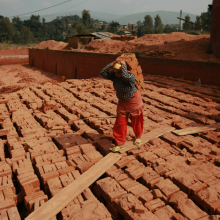A new international study, co-authored by Dr Joe Jacob of UCL and colleagues worldwide including the Johns Hopkins Research Center, has revealed the risks of lung damage faced by brick kiln workers in Nepal. Researchers measured the air quality the workers breathe and assessed their lung health, providing the most detailed look yet at this overlooked occupational group.
Brick kilns and lung health
Brick making is physically demanding and carried out in dusty, smoky conditions. Past research has suggested a risk of lung diseases such as silicosis (which Breathing Matters wrote about previously), but few studies have directly measured exposures in real time.
What the study found
 The team studied 10 kilns in Bhaktapur, Nepal, involving long-term workers and their families. They measured personal exposure to dust and gases, alongside breathing tests and chest scans.
The team studied 10 kilns in Bhaktapur, Nepal, involving long-term workers and their families. They measured personal exposure to dust and gases, alongside breathing tests and chest scans.
- Dust exposures were high: Almost 70% of workers were inhaling tiny silica dust particles that can lodge deep in the lungs at levels above safety recommendations. The highest exposures were among stackers and haulers.
- Toxic gases added to the problem: Nearly half of these workers also had exposure to sulphur dioxide, a gas that can irritate and inflame airways.
- Pollution at home too: Even away from work, levels of fine air pollution (PM₂.₅) in homes were well above global guidelines.
- Subtle lung changes: Only a small number of workers showed reduced breathing ability on standard lung tests. However, advanced chest scans revealed early signs of small airways damage and other lung changes in many participants.
Why it matters
Notably, none of the workers showed the “classic” signs of silicosis on chest X-rays, despite their high exposures. This suggests that traditional imaging may miss early or hidden damage, while advanced scans can reveal problems much sooner.
Beyond Nepal
Although this study focused on Nepal, brick kilns are common in many countries. The findings highlight that dust and smoke exposures remain a present-day issue, not just a problem of the past, and underline the importance of protecting the lung health of workers and their families.
You can read the full article here.
[Posted August 2025]
Recent Articles
- Do mucus-thinners help people with bronchiectasis?
- Get ready for Christmas with Breathing Matters
- 2026 global adventure challenges!
- How bacteria and iron can affect lung inflammation
- Guidelines challenged by new bronchiectasis study
- New IPF treatment brings fresh hope
- Thank you for making #Breathtember matter
- A very merry Christmas concert
- Predicting the unpredictable
- The mental health burden of bronchiectasis
- Hidden hazards in every breath
- Brinsupri™: A new chapter in bronchiectasis care
- August 2025 Newsletter
- #Breathtember: every breath matters
- Make 2026 a year to remember



